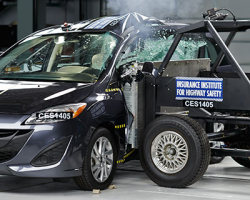
— The small overlap crash test performed by the Insurance Institute for Highway Safety (IIHS) has claimed more victims, this time in the small car category.
The test is conducted by replicating what happens when the front corner of a car collides with another vehicle or object. It's more demanding than a head-on crash test because the small overlap test makes 25 percent of a car's front-end on the driver's side hit a rigid barrier at 40 mph.
The test is harsh because the car's main structures of the front-end crush zone are bypassed, making it hard for the vehicle to absorb crash forces. Real-world accidents like this can easily cause the occupant compartment to collapse.
IIHS uses a rating system of Good, Acceptable, Marginal and Poor, and only the Mini Cooper Countryman earned a "good" rating in the small overlap crash test. IIHS says the Countryman did well based on measurements to the test dummy indicating a driver probably wouldn't suffer serious injuries in a crash.
Five small cars earned an acceptable rating, two came in marginal and four earned poor ratings.
Two of the cars are electric models that can have problems with the test because of the heavy batteries used in the cars.
The Chevy Volt earned an "acceptable rating" because the driver space was maintained and dummy measurements reflected a low chance of severe injuries.
The same can't be said of the electric Nissan LEAF.
The LEAF got blown away by the Volt in the electric car category as the LEAF experienced 16 inches of intrusion in the lower occupant area and 14 inches in the upper occupant compartment. The test dummy indicated a driver would probably suffer injuries to the left thigh, knee and lower leg. Those little issues caused the Nissan LEAF to receive a "poor" rating.
Another car that received a "poor" rating because of serious damage to the occupant compartment was the 2014 Fiat 500L.
IIHS says the 500L steering wheel was knocked back and to the right of the driver because the structure entered the driver area. Further, the test dummy's head slammed into the A-pillar because the front air bag deployed out of position.
Worst-Performing Models
No automaker wants to be listed as having a vehicle among the "worst-performing models" of anything, but the Mazda5 earned that label in the small overlap test. IIHS says the Mazda5 shares that distinction with two other cars: the 2014 Kia Forte and the 2012 Prius v.
The Mazda5 took a beating in the test and the dummy took its own beating. The driver dummy had severe injuries to its left thigh and lower leg, a likely pelvis fracture and the dummy seated in the rear passenger seat suffered rib fractures and/or other internal organ injuries.
Additional Mazda5 problems listed by IIHS include:
1. The steering wheel moved to the right and the dummy's head barely contacted the front air bag before sliding off the left side.
2. The seat belt allowed the dummy's head and torso to move too far forward and caused the head to make contact with the left side of the dashboard.
3. The side curtain air bag didn't deploy at all and exposed the head to contact the side structure and outside objects.
4. The driver door unlatched during the test, something that shouldn't happen and could cause an occupant to be ejected.
IIHS said since 2003, the Mazda5 is the only 2014 model evaluated to earn anything less than acceptable in the side test.
Mazda responded by pointing out the Mazda5 did receive a "good" rating in the frontal moderate overlap and roof strength tests.
"We take these results seriously, and are studying the results of these IIHS tests as we consider the design of future vehicles." - Mazda
2014 Small Overlap Crash Test Ratings For Small Cars
Good
Acceptable
- Chevrolet Volt
- Ford C-Max Hybrid
- Mitsubishi Lancer
- Scion FR-S (built after December 2013)
- Subaru BRZ (built after December 2013)
Marginal
- Scion xB (built after February 2014)
- Hyundai Veloster
Poor




